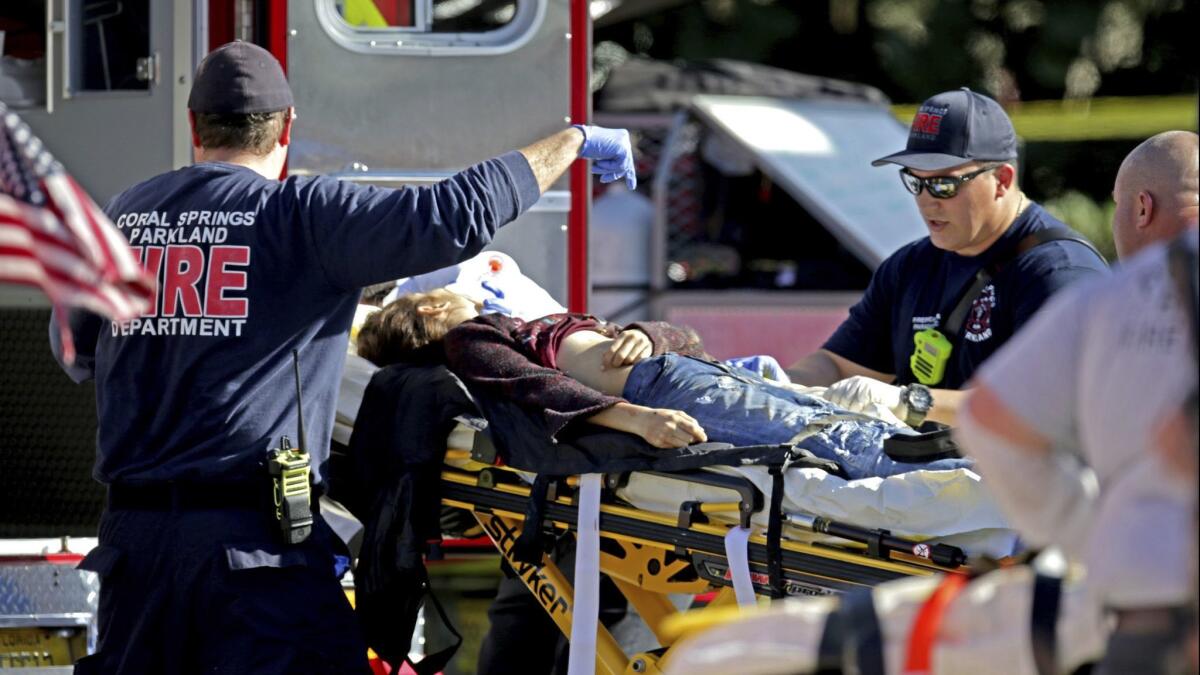School homicides have become more common and more deadly, CDC data show

A new report from the Centers for Disease Control and Prevention confirms what too many students across the country already know: The incidence of mass homicides on school campuses has risen steeply in recent years, as has their toll.
Between 1994 and 2018, there were 38 school rampages that resulted in multiple fatalities. Five of those occurred during the 2017-2018 academic year, which ended in June, and three others were in the 2016-2017 school year, according to a study in Fridayâs edition of the CDCâs Morbidity and Mortality Weekly Report.
All told, 121 people died in school homicides with multiple fatalities over the 24-year period. But 29 of those deaths â accounting for nearly one-quarter of the total â were shootings that came in just three incidents during the most recently completed school year. Seventeen students and teachers were killed on Feb. 14, 2018, at Marjory Stoneman Douglas High School in Parkland, Fla., 10 were shot to death three months later at Santa Fe High School in Texas, and two students were killed at Aztec High School in Aztec, N.M., before the gunman took his own life.
During the 2017-2018 school year, an American studentâs likelihood of dying in a school shooting was one in 2 million. That was the highest by far in the entire period studied, the CDC researchers found.
Counting only the incidents through June 2017, the spasms of violence claimed lives in patterns that reflect the nationâs makeup: Females perished as often as males, and two-thirds of the victims were white. A majority of the homicides occurred in urban or suburban schools.
There was one exception. Nearly a quarter of the victims were between 5 and 9 years old.
Among those with known motives, the perpetrators were most often propelled by a desire for retaliation. In 39% of these incidents, the killer was thought to have been reacting to bullying, rivalry between peer groups, or a bad grade. Gang-related activity was seen as a factor in 34% of incidents, and âinterpersonal disputesâ played a role in 29% of them. (More than one motive was considered in each event.)
But though mass school shootings command the nationâs rapt attention, their numbers and their toll are dwarfed by the daily drumbeat of one-on-one violence taking place in and around the nationâs schools.
Just over three-quarters of all school homicides took place in a single act of one-on-one violence, the CDC researchers found. These incidents tended to occur in urban schools (60%), and they often involved a teen-aged African American male perpetrator (39% of those identified by ethnicity or race) and an African American male victim (53% of those identified by ethnicity).
Indeed, the single-victim homicide rate was was 8.27 times higher for non-Latino black youths than for non-Latino white youths, the study found.
Those grim statistics âare consistent with national dataâ showing not only a higher risk of homicide deaths in urban areas, but higher rates of homicide death among minority youths, the CDC team wrote.
Gang-related activity was cited as a motive in 58% of these killings. But other daily realities that set off impulsive adolescents â interpersonal disputes, retaliation, dating partner problems â were cited as motives in almost three-quarters of these homicides.
About 63% of one-on-one school homicides were carried out with a firearm, typically in the hands of an adolescent. Stabbings represented 24% of these deaths, and 8% were due to blunt force.
Guns were much more likely to be used in âmultiple-victimâ school homicides. Between 1994 and 2018, 115 of the 121 victims who perished in such incidents â 95% â died by gunshot. Stabbing claimed two lives, and blunt force trauma was the cause of death in four school-based homicides involving more than one victim.
Between 2004 and 2016, school homicides of all stripes claimed 423 lives, the researchers found. Thatâs roughly the seating capacity of a Boeing 747 jumbo jet.
In the wake of the shootings in Parkland, the Trump administration and the National Rifle Assn. have called for the training and arming of teachers and school administrators so that they can respond to outbreaks of violence. And on Jan 2, the Marjory Stoneman Douglas High School Public Safety Commission issued a call to allow some teachers to carry weapons on campus.
Lawmakers in 19 states have proposed bills to allow or expand the presence of guns in K-12 schools, according to the Giffords Law Center to Prevent Gun Violence; none have succeeded so far. At least eight states currently allow, or do not specifically prohibit, concealed weapons in K-12 schools.
Dr. Rebecca Cunningham, an emergency physician at University of Michigan who has studied the toll of firearms on children, said she was struck by the new studyâs analysis of killersâ motives. Whether a perpetrator killed one person or several, his actions were often a response to interpersonal disputes, bullying, insults, romantic break-ups or disappointments, she said.
âThereâs a lot of push for people to jump to the conclusion that these are gang-relatedâ killings, Cunningham said. But in three-quarters of single-victim school homicides and almost 90% of multiple-victim school homicides, âtypical teens thingsâ were seen as a factor. âBullying, talking smack, someone talking about your girlfriend â this is common, and those are typically the conflicts that escalate,â she said.
When kids donât have access to firearms, these disputes are often resolved in fistfights and sometimes with knives; either way, multiple deaths are rarer, Cunningham said. When firearms are more readily available, she said, âthese escalate to become more lethal incidents.â
One in three U.S. homes with children under 18 has a firearm, and in 43% of those homes, it is kept unlocked and loaded, Cunningham and her colleagues recently reported in the New England Journal of Medicine.
Cunningham also said schools need to do more to coach students and administrators in the skills they need to defuse potentially violent situations, and school leaders need better tools and more resources to identify and help kids with substance use and other problems that make them combustible.
Twitter: @LATMelissaHealy
MORE IN SCIENCE







